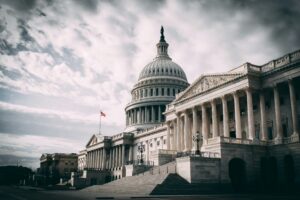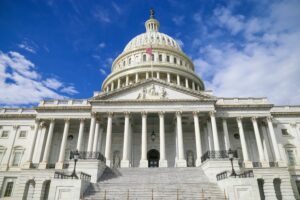Disclaimer: Many of the developments discussed below are fluid and may change rapidly. The information is relevant and accurate as of May 5, 2025
On April 30, President Trump surpassed his first 100 days in the White House for his second, non-consecutive term. These first 100 days have been busier than the first Trump term, with President Trump signing over 100 executive orders on issues such as trade, immigration, education, federal workforce, and regulatory burden, as well as dismantling efforts of the previous Biden administration. Almost all of Trump’s Cabinet was confirmed and sworn in, accelerating key activities of his administration at the federal level. Additionally, the Republican Party’s slim majorities in the House and Senate has aided the administration in pursuing objectives and confirming officials aligned with Trump without significant pushback from the legislative branch.
While the administration has focused on various priorities impacting various parts of government, below is information on key priorities, including trade policy, tax policy, federal workforce reduction, and the Make America Healthy Again (MAHA) agenda, as well as insights on the current state of affairs, potential next steps from the administration, and possible impacts on trade associations.
Trade Policies
During his campaign, Trump reiterated his plan to impose tariffs on U.S. trading partners to address trade deficits and unfair trading practices. Trump has also suggested tariffs, or even the threat of them, can be used as a negotiating tactic, though there are advisors in the administration who are pursuing more permanent tariffs to bring manufacturing back to the U.S. While Trump did not issue any executive orders on tariffs on his first day, he quickly began targeting key trading partners, particularly Canada, Mexico, and China, with increased duties. Though he ultimately paused planned tariffs on Canada and Mexico for those products which are compliant with the U.S.-Mexico-Canada Agreement (USMCA), Trump did impose increased duties on China, which have escalated over the past two months following growing tension between the two countries. Additionally, Trump has implemented increased tariffs for steel and aluminum imports without any exceptions, as was the case during his first term, as well as tariffs on foreign-made autos with additional duties on foreign-made auto parts recently being imposed.
Read More
Trump’s key plan to address trade deficits has been to implement reciprocal tariffs, and he asked several agencies to undertake review of tariff and non-tariff measures imposed on the U.S. by trading partners. Trump’s response to the findings from officials was touted as “Liberation Day,” in which a baseline 10% tariff rate would be set for all imports with higher duties for those countries with higher trade imbalances with the U.S. Following a significant negative impact on the U.S. market, and the threat of retaliatory tariffs by trading partners, Trump announced a 90-day pause on higher rate reciprocal tariffs until July. However, the baseline 10% rate for imports remains in place, as well as other duties on steel, aluminum, autos, and auto parts. Trump has also hinted at plans for tariffs against specific industries, including pharmaceuticals.
In terms of specific impact on trade associations, the primary impact is the introduction of uncertainties of how the U.S. trade policy will influence global business operations as well as the potential for other countries to impose retaliatory tariffs which could influence the market for certain products. While Trump had previously noted there would be no exemptions or exceptions granted for specific commodities, in recent comments, he has noted more willingness to consider exemptions. Therefore, if associations are concerned about the impact of tariffs on the trade of their products, they may want to consider filing comments to the administration requesting exemptions, particularly if those products are not or are unable to be produced in the U.S. Additionally, tariffs may impact attendance at annual meetings or conferences or limit exhibits or sponsors at conferences due to budgetary concerns.
Over the next few months, the administration will work on negotiations with trading partners to finalize deals to address trade imbalances. The administration has already begun these negotiations with several countries, though it remains unclear whether significant trade deals will be finalized by July such that reciprocal tariffs may not be reimposed. Further, the fluctuation of the U.S. market may have an influence on future decisions by the administration with regard to severity of tariff and other trade measures.
Tax Policies
One of the key pieces of legislation from Trump’s first term was the Tax Cuts and Jobs Act of 2017 (TCJA), which constituted a major overhaul of the U.S. tax code, introducing a number of permanent and temporary tax reforms with the goal of stimulating economic growth and enhancing U.S. competitiveness. TCJA has several provisions which are set to expire in 2025 for both businesses and individuals. For businesses, provisions for pass-through income deduction, business expense deductions, and international taxes will change if the provisions are not extended by the end of 2025. Further, while the reduction in the corporate tax rate from 35% to 21% was made permanent under TCJA, reopening the tax code to extend other provisions could result in changes to this rate.
Read More
Given the Republican control of both the House and Senate, efforts are being made to preserve many of the TCJA provisions which are set to expire. However, Congress will need to find a source of funding for any extensions. It has been suggested that the collection of tariff duties could help fund these provisions. As with the passage of TCJA in 2017, Congress will need to utilize a process known as budget reconciliation which allows for passage of legislation with a simple majority in the Senate versus the 60-vote threshold typically necessary for the Senate. With reconciliation, the House and Senate must adopt identical budget resolutions which will serve as a basis for House and Senate committees to draft legislation prior to submitting recommendations to their respective budget committees. While the House and Senate can work on separate reconciliation bills before going to conference, in recent years, the Senate has waited for the House to act before introducing a bill in the Senate. Prior to their April recess, both chambers adopted a budget resolution, and committees are set to begin markups with a deadline of May 9 to complete committee work to ideally pass a bill for Trump to sign by Memorial Day. However, there are significant differences between the House and Senate resolutions, with the House budget resolution outlining the need to cut $1.5 trillion in spending by committees while the Senate has only proposed $4 billion in committee spending cuts, though they expect to identify further areas for cuts. For the House resolution, a majority of the cuts are for the Energy and Commerce Committee, primarily focused on “fraud, waste, and abuse” in Medicaid.
President Trump has recently made comments suggesting that the tax-exempt status of some nonprofit organizations should be removed based on their mission and activities. Further, as noted previously, significant funding will be needed to extend any TCJA provisions set to expire in 2025. Some have suggested that taxing associations at the corporate tax rate could be a means to generate funding. Such a proposal would tax the net of all non-donation revenue for tax-exempt organizations, including membership dues, sponsorships, educational program revenue, and investment income. Removal of the tax-exempt status for nonprofit organizations, including associations, could have negative consequences in terms of either raising dues or reduced activities to account for tax payments. Further, specific to healthcare associations, impacts on Medicaid could have negative implications for operations or association activities.
As we approach the planned deadline for markups by House and Senate committees, it remains to be seen how both chambers will pass reconciliation bills and how negotiations will proceed in conference, particularly given the targeting of Medicaid. Further, the reconciliation bill includes more than just the extension of TCJA provisions – it also seeks to raise the debt ceiling and boost funding for border security. The slim majorities in both chambers as well as competing interests amongst Republicans may make it difficult to pass reconciliation later this month.
Reducing Federal Workforce
Trump as well as many of his advisors and those within the Republican party have targeted the federal government as being too large and inefficient, and instituted efforts to reduce the size of the federal workforce as well as the budgets of federal agencies. This has primarily been achieved through the creation of the Department of Government Efficiency (DOGE), which has been led by Elon Musk. DOGE has an ambitious goal of cutting $1 trillion from federal spending through the end of the current fiscal year, which ends in September. DOGE has visited many federal agencies since its establishment, reviewing budgets and other documentation, ordering many federal employees to advise their work product as a means to demonstrate their contribution to the government. The efforts of DOGE have led to the cancellation of many federal contracts, leases for federal buildings, and a significant reduction in the federal workforce through offering “buyouts” to employees who may wish to avoid possible firing. Most notably, the U.S. Agency for International Aid (USAID) was almost entirely eliminated following being targeted by DOGE, with more than 80% of its programs cut and the agency being absorbed by the State Department.
Read More
Many federal agencies have also announced or begun work on plans to resize or restructure their organizations. For example, the Department of Health and Human Services (HHS) announced cutting 20,000 full-time employees across agencies within the Department, consolidating various divisions, including communications, and dismantling different initiatives, though HHS Secretary Robert F. Kennedy, Jr. did make comments that the Department could be bringing some of the fired employees back. Many other federal agencies have implemented hiring freezes, and the administration is likely to implement policies that would require firing a number of employees for every one hired, with an exception for political appointees. Republicans in Congress have also announced a DOGE Caucus, which exists and operates separately from DOGE, and is interested in improving government efficiency and returns on spending as well as eliminating waste, fraud, and abuse. While no official plan of action has been developed for the caucus, it may act in an advisory capacity to determine future budget allocations. Additionally, several Republican-led states, such as Florida, have announced similar “DOGE” efforts to reduce inefficiencies and address waste and fraud.
Significant reductions in the federal workforce have led to uncertainties regarding career officials who remain at various federal agencies. This may impact associations who have been working with different officials on key issues, rulemakings, or guidance, meaning alternate contacts may need to be identified. Further, the reduction in workforce and budgets may impact the ability of agencies to act on priorities for associations, such as response to petitions or providing guidance to industry, which may be compounded by the directive from the administration for deregulatory action.
Over the next several months, there may be additional “buyout” opportunities for different federal agencies as the administration seeks to cut a significant percentage of the overall government workforce. Further, low morale amongst federal employees as well as disagreements with the objectives of the administration for their agency may lead more employees to leave the government. As Elon Musk is reportedly shifting away from leadership at DOGE, workforce and budget reduction efforts may move to agencies or at the direction of Congress through budget allocations.
Make America Healthy Again (MAHA)
Following an unsuccessful presidential campaign, several months before the November 2024 election, Robert F. Kennedy, Jr. announced support for Donald Trump, and touted plans to “Make America Healthy Again.” The Trump campaign viewed this messaging as a winning strategy, and Kennedy was rewarded following Trump’s victory with a nomination to be Secretary of the Department of Health and Human Services (HHS). HHS has jurisdiction over several federal agencies, including the Food and Drug Administration (FDA), National Institutes of Health (NIH), Centers for Disease Control and Prevention (CDC), and Centers for Medicare and Medicaid Services (CMS).
Read More
In February 2025, Trump issued an executive order to establish a “Make America Healthy Again” (MAHA) Commission, which would be chaired by Secretary Kennedy and include other Cabinet Members as well as various federal agency officials, such as FDA Commissioner Makary. The initial mission of the MAHA Commission is “to advise and assist the President on how best to exercise his authority to address the childhood chronic disease crisis.” Therefore, the Commission will study the scope of this crisis and any potential contributing factors (e.g., diet, environmental factors), advise Trump on informing the public about this crisis, and provide Trump with recommendations for policy and strategy to address the crisis. An assessment is due to Trump within 100 days of the establishment of the Commission (i.e., May 24, 2025) and a strategy to address key findings from the assessment is due within 180 days (i.e., August 12, 2025). The Commission has held some meetings, including with “MAHA Moms,” which focused on nutrition, physical activity, over-medicalization and standards of care, and environmental impacts. The administration has also posted on social media with Cabinet Members and “MAHA moms” struggling to pronounce food ingredients on labels. Further, Secretary Kennedy has initiated several efforts related to the MAHA agenda, including a push to phase out synthetic food dyes, requesting the FDA look into a pathway to eliminate the process for companies to affirm whether or not their products are “generally recognized as safe” (GRAS), and supporting research to identify the cause of autism.
Particularly for those trade associations in the food/nutrition and healthcare space, recommendations and activities stemming from the MAHA Commission and the overall MAHA agenda could have a significant impact on strategy and association activities. Depending on those advisors influencing administration efforts or those scientists undertaking research on key areas of focus for the Commission, certain food products, ingredients, production practices, medications, and/or medical recommendations (e.g., vaccines) could be targeted. If there are specific concerns for your industry sector, associations should work with their staff to monitor the efforts of the Commission and engage, as warranted, as well as consider possible efforts to correct any misinformation.
Over the next few months, the Commission will provide their assessment to Trump along with recommendations to tackle childhood chronic diseases. There may be opportunities to engage through public meetings, and associations should track these opportunities if there are particular concerns with any potential outcomes from the Commission. Federal agencies such as FDA may also issue rulemakings that align with key objectives of the MAHA agenda, such as proposing to eliminate the self-affirmed pathway for GRAS products.
Kellen represents dozens of associations representing industry sectors from food and nutrition to healthcare to building products and materials, and we’re prepared to help our associations better understand the potential impacts of this administration’s activities on their business and strategy. Membership in an association helps industry sectors have a collective voice, including engagement with key stakeholders such as federal regulators and policymakers. Associations also offer an opportunity for industry to improve operations across sectors for the benefit of those working within those industries as well as customers and consumers.
Associations Matter More Than Ever
In today’s evolving environment, being part of an industry association offers critical strategic value. Associations provide a unified voice to advocate effectively with government and stakeholders, ensuring member interests are represented and protected, offering peer support, regulatory guidance, and coordinated crisis response. Membership also enhances company credibility, provides access to exclusive insights and resources, and creates opportunities for meaningful engagement with decision-makers
Kellen's Comprehensive Approach to Public Affairs
In the face of today’s geopolitical shifts, digital transformation, and crises impacting industries, Kellen’s Public Affairs team builds powerful relationships that navigate complex political landscapes to build meaningful outcomes and shape public opinion. From the Hill to statehouses nationwide, our team has deep-rooted relationships that provide unparalleled access to the policymakers, regulators, and media that deliver impactful campaigns.
Advocacy
✔️ Government Relations
✔️ Regulatory Affairs
Strategic Communications
✔️ Crisis Management & Media Relations
✔️ Social/Digital/Sentiment Campaigns
Technical Service
✔️ Standards Development & Certified Product
✔️ Directories Code Development & Compliance



